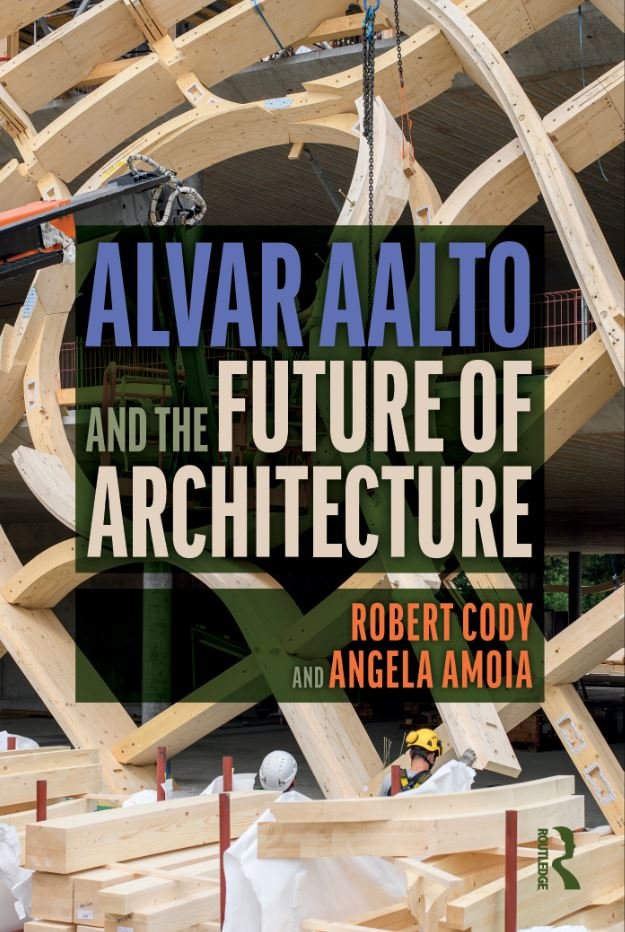Alvar Aalto and the Future of Architecture
ISBN 9780367749736
Publishing on September 9, 2022
For Purchase
For more information - Click Here
ArchDaily
Interview
Angela Amoia and Robert Cody: “Technology should push imagination”
Vladimir Belogolovsky met with the founders of Amoia Cody Architecture, DPC, and NYIT professors to discuss their first book, Alvar Aalto and the Future of Architecture.
Book Description
In the contemporary practice of architecture, digital design and fabrication are emergent technologies in transforming how architects present a design and form a material strategy that is responsible, equitable, sustainable, resilient, and forward-looking. This book exposes dialogue between history, theory, design, construction, technology, and sensory experience by means of digital simulations that enhance the assessment and values of our material choices. It offers a critical look to the past to inspire the future.
This new edition looks to Alvar Aalto as the primary protagonist for channeling discussions related to these topics. Architects like ALA, Shigeru Ban, 3XN, Peter Zumthor, and others also play the role of contemporary guides in this review. The work of Aalto and selected contemporary architects, along with computer modeling software, showcase the importance of comprehensive design. Organized by the 5 T’s of contemporary architectural discourse - Typology, Topology, Tectonics, Technic, Thermodynamics – each chapter is used to connect history through Aalto and develop conversations concerning historical and contemporary models, digital simulations, ecological and passive/active material concerns, construction and fabrications, and healthy sensorial environments.
Written for students and academics, this book bridges knowledge from academia into practice and vice versa to help architects become better stewards of the environment, make healthier and more accountable buildings, and find ways to introduce policy to make technology a critical component in thinking about and making architecture.
Table of Contents
00 Introduction – Alvar Aalto and the Future of Architecture
01 Topology – Design in light of Place
Situatedness
Location
The Surrounding World
Places and Boundaries (Being-in-the-World)
Grounding and Contouring our View
Position and Orientation
Aalto's Form-System
Enfolding our Surroundings
Topological Parameters
Contemporary Projects:
Zollverein School, Germany, SANAA Architects, 2005
The Oodi Helsinki Central Library, ALA Architects, 2018
02 Typology – Envelopment(s) of Space
Vernacular Typologies
Extended Typologies
Envelopment(s) of Space and Material
The Cave and Envelopment
Finding Type-Form (The Court, The Hall, and the Interior)
The Courtyard
Compartition
Aalto's Typologies
Orientation and Boundary Typology
Aalto's Typological Elasticity
The 21st Century Building Type
Contemporary Projects:
W.I.N.D. House, Netherlands, UN Studio, 2014
Perez Art Museum Miami, Herzog & de Meuron, 2013
03 Tectonics – Elements and Atmospheres
Architectural Tectonics
Aalto's Tectonic Imaginations and Form Systems
The Agency of Material – Elements
The Agency of Material – Atmospheres
The Agency of Material – Ecology
Wood as a Building Material
Aalto's Embodiment - An Architecture of Ecology:
Nature of Elements - The Villa Mairea,
Nature of Atmosphere – Jyväskylä University,
Nature of Ecology – Muuratsalo
An Ecological Tectonic – Säynätsalo
The Agency of Information - Contemporary Embodiment
Contemporary Projects:
Kunsthaus Bregenz, Austria, Peter Zumthor, 1997
Maggie's Yorkshire Leeds, Heatherwick Studios, 2020
04 Technic – Flexibility and the New Standard
Art + Technology | Making + Knowing
Performance-based, Parametric, Algorithmic, and Generative Design
Alvar Aalto and Standards
Elastic Form Production
The Elastic Plan
Elastic Design and Flexible Fabrication
Material Modular Standards
Natural Standardization
Towards an Ecological Standard
Contemporary Projects:
The Swatch Headquarters, Switzerland, Shigeru Ban Architects, 2019
International Olympic Committee (IOC) Headquarters, Switzerland, 3XN, 2019
05 Thermodynamic – Health and Instruments of Sensation
Seeing and Feeling
Thermodynamical Systems
Thermodynamic Materialism
The Healthy Body and its Sensory System
The Conditions of Atmosphere
Aalto's Instruments - The Super-Technical Creation
Conditioning the Mind
Aalto's Sensibility – The Phenomena of Light
The Conditions of Building
The Healthy Building and its Sensory System
Neuroscience and the Future of Architecture
Contemporary Projects:
Löyly Sauna, Finland, Avanto Architects, 2016
Minna no Mori Gifu Media Cosmos, Japan, Toyo Ito & Associates, 2015
Author(s)
Biography
Robert Cody, AIA, NCARB, LEED AP, is Partner of Amoia Cody Architecture, Professor of Practice, and Former Associate Dean and Chair at the New York Institute of Technology School of Architecture and Design. For over 30 years, he has worked on projects from wood-frame houses to precast concrete office buildings, interior renovations to free-standing towers, design competitions to physical construction, and ecological design, to The Museum of Modern Art. In addition, Cody has taught design studios at all levels with particular concentration in the comprehensive design studio, building construction, architectural theory, and study abroad in Italy and Scandinavia. He has also been the New York Tech NCARB AXP coordinator and AIAS faculty advisor since 2012.
Angela Amoia is a Partner of Amoia Cody Architecture and Adjunct Associate Professor of Architecture at the New York Institute of Technology School of Architecture and Design. Amoia has practiced and taught history, theory, architecture studios, including the comprehensive design studio, and study abroad in Italy since graduating from Columbia University with a master’s degree in Advanced Architectural Design. Her role as project manager ranged in scale from skyscrapers to large-scale academic facilities and residential houses and loft buildings..



